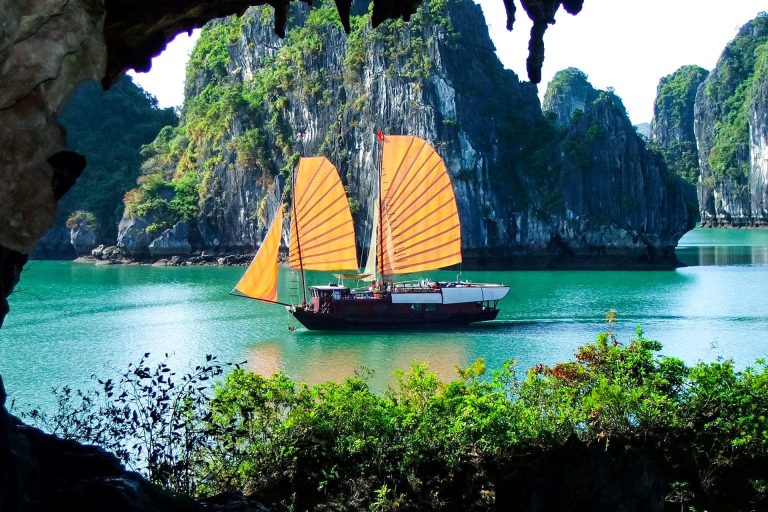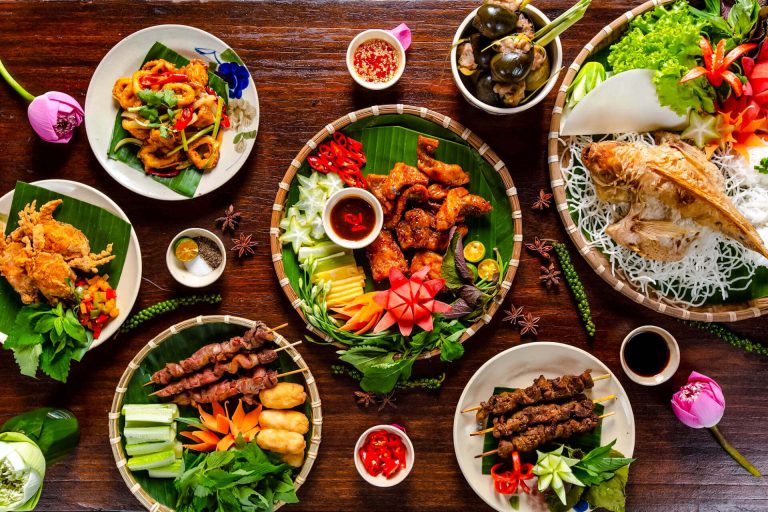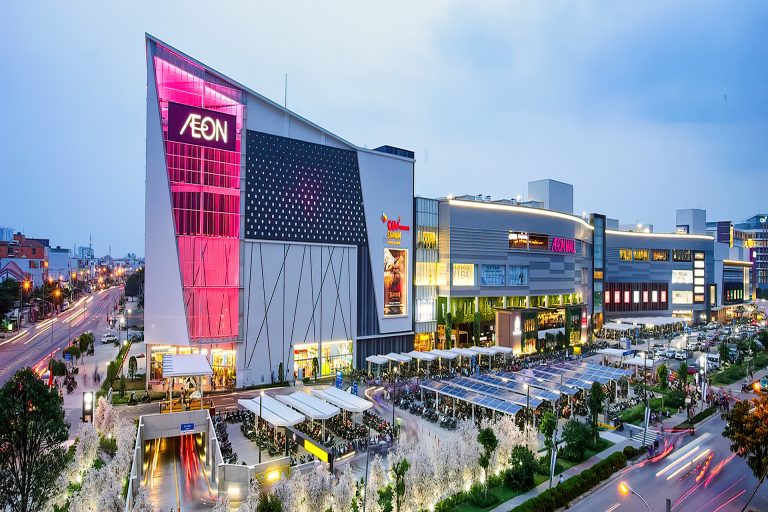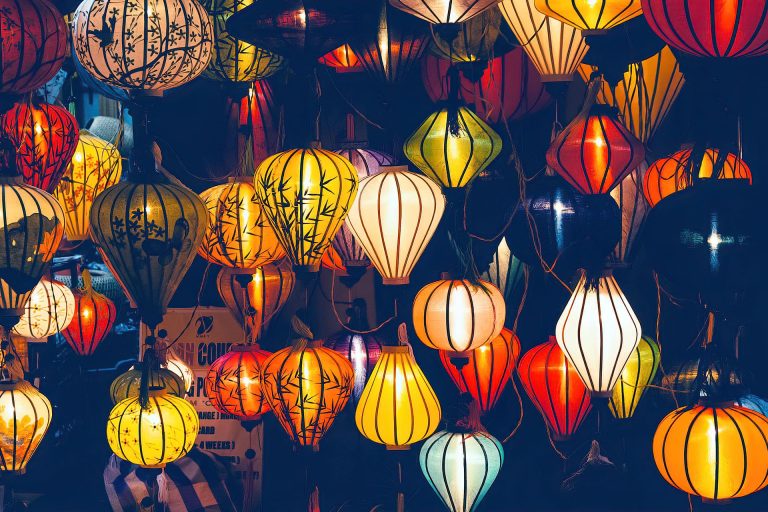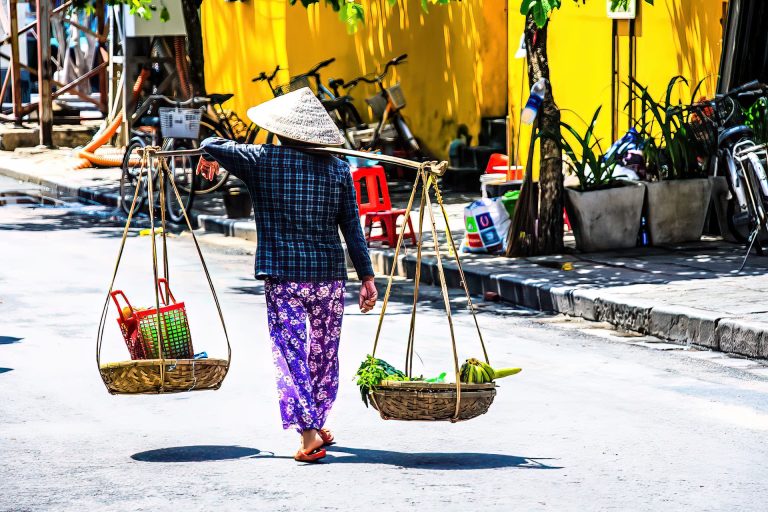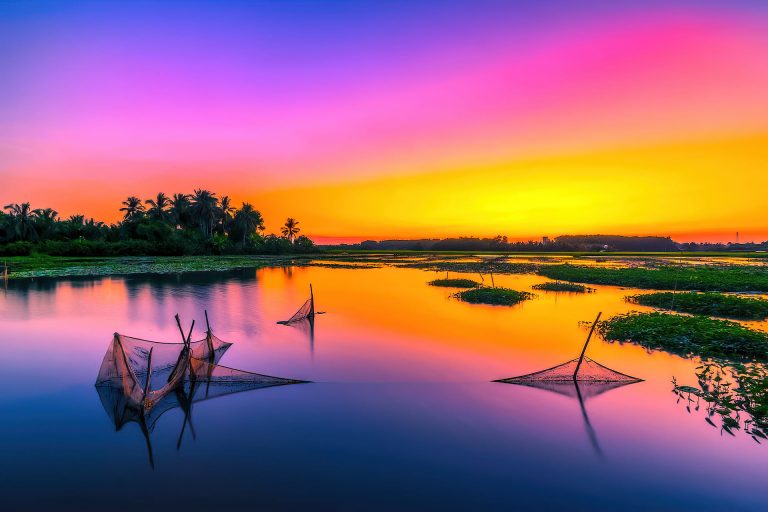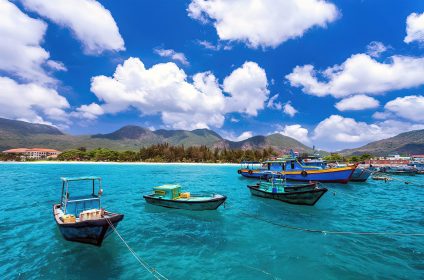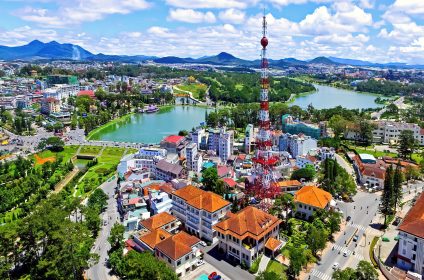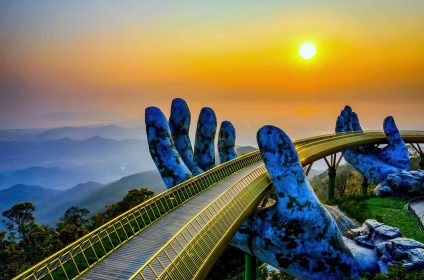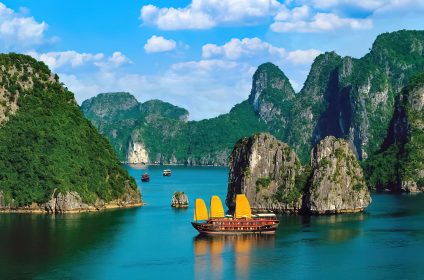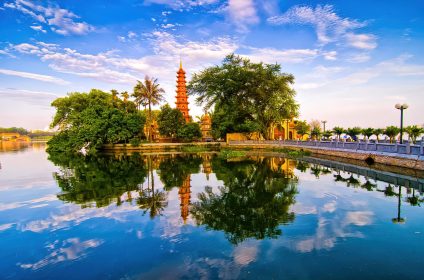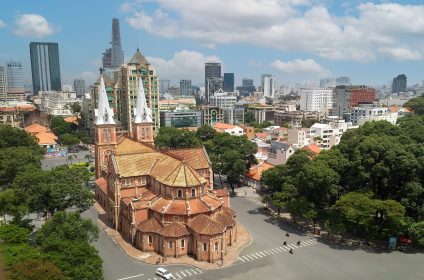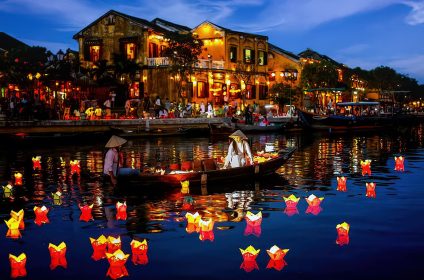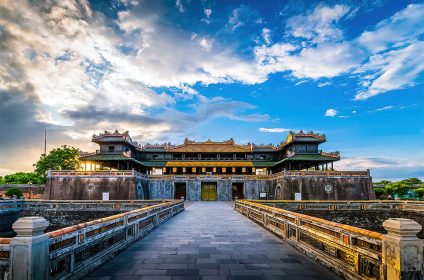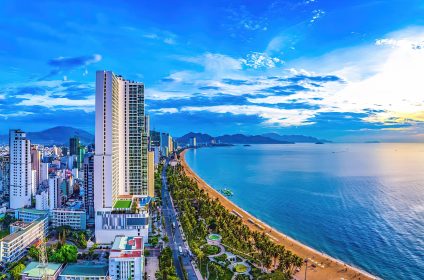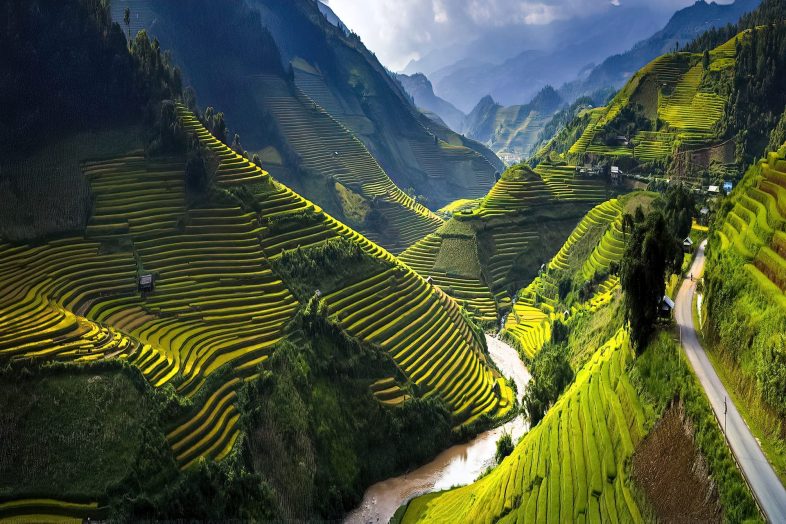
Attractions In Vietnam
Vietnam will show you the Asia you’ve always wanted to see. Lush rice terraces at the foot of the beautiful mountains, colorful water markets along the rivers of the Mekong Delta, and Hanoi’s never-ending city life, where everything from schoolchildren to refrigerators to massive piles of veggies is delivered on the backs of numerous motorbikes. Despite the fact that Vietnam’s major cities are gradually becoming sophisticated Asian metropolises, traditional culture is never far away.
Landscapes And Nature In Vietnam
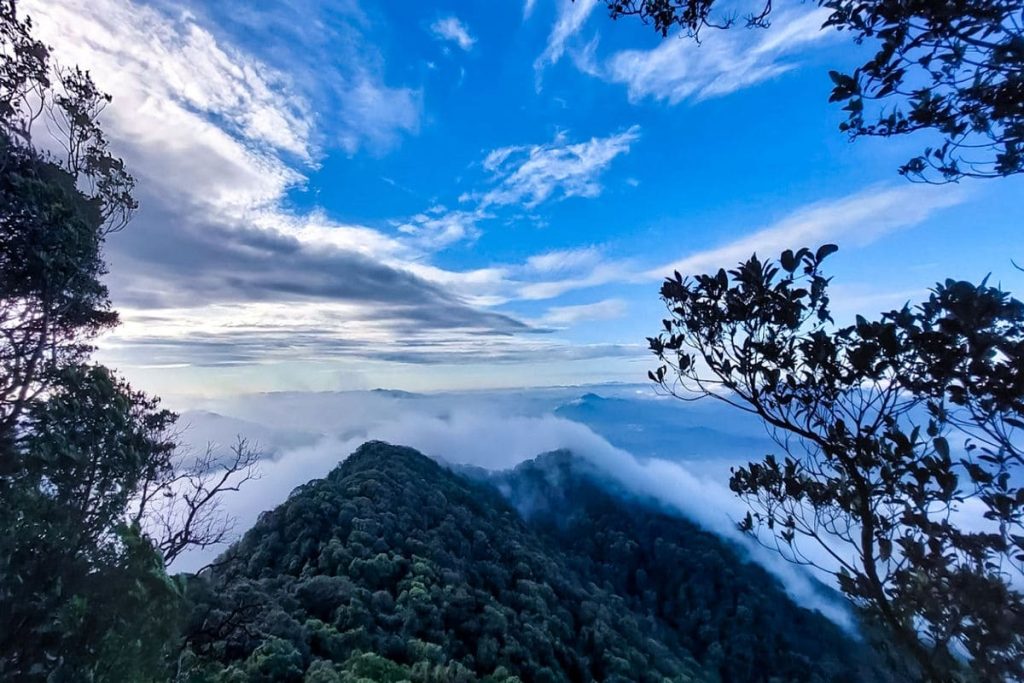
Few countries are blessed with as enthralling landscapes as Vietnam. Many visitors regard the country’s gorgeous limestone landscapes, pristine beaches, islands, mountain ranges, rice paddies, and lakes as its finest attractions. Ha Long Bay, one of Vietnam’s most popular tourist destinations, is made up of thousands of limestone pillars and islets surrounded by deep jungle vegetation. Floating fishing towns, caves, and island lakes can be found among the lively harbour life. Lan Ha Bay, which lies nearby, is as beautiful but less crowded. Visit Sa Pa and the Muong Hoa valley for views of local rice terraces set against bamboo trees. Tam Coc, near Ninh Binh, is also to the north. This area is well-known for its karst landscapes, rice fields, and caverns, and it is best explored by boat.
The largest island in Vietnam is Phu Quoc, located off the coast of the country. Its beautiful palm-fringed beaches and rainforests equal those of any other island in the planet. The Mekong Delta is, of course, the most well-known in the south. The Mekong River pours into the South China Sea through a tangle of tiny streams here. It is a lush, verdant region that supplies half of Vietnam’s agricultural production. It provides breathtaking vistas of rivers and rice fields for as far as the eye can see. Natural scenery and culture coexist here, as life revolves around water. The Mekong River’s waterways serve as vital modes of transportation and host floating markets.
In terms of natural wonders, the country’s national parks provide the best options. Phong Nha-Ke Bang National Park is a UNESCO World Heritage Site known for its natural caves and grottos, underground rivers, cave beaches, and beautiful stalagmites and stalactites. Cuc Phuong National Park is a good place to see wildlife.
Ba Be National Park
This subtropical national park gets its name from Ba Be Lake, a huge forest dotted with cascading waterfalls and bat caves. The lake’s gentle currents are great for boating, swimming, and fishing excursions. On land, spend time exploring the hiking paths that enclose the lake or cycling the wonderful roads that run beside it. The Tay, one of northern Vietnam’s largest ethnic minority groups, live in portion of Ba Be National Park. The Tay invite visitors to their raised stilt huts near the lake with traditional homestay experiences.
Phong Nha-Ke Bang National Park
Phong Nha-Ke Bang is an adventurer’s dream, with stubborn rivers, vibrant jungles, and massive caves. This UNESCO World Heritage Site is home to some of the world’s largest caverns, as well as numerous smaller systems hidden beneath towering, jungle-topped karsts. Caving tours can range from afternoon outings to strenuous four-day expeditions, depending on your interests. The national park offers kayaking, cycling, and hiking options above these subterranean cave worlds. Phong Nha Town is a lovely place to unwind at the end of the day.
Cuc Phuong National Park
Cuc Phuong is Vietnam’s first national park, having been established by Ho Chi Minh himself. It has a dense forest of millennia-old trees, prehistoric caves, botanical gardens, and two animal sanctuaries worth seeing. The Endangered Primate Rescue Centre recovers and rehabilitates unlawfully acquired primates, whereas the Turtle Conservation Centre operates rescue, conservation, and breeding programs. Spend your day walking, bird-watching, and kayaking, or staying in the welcoming Muong people’s stilt huts.
Bach Ma National Park
Rarely-visited Bach Ma is located midway between Hue, the imperial city, and Hoi An, the ancient town. The park has seen minimal growth since the early twentieth century, and it still contains a modest collection of French colonial mansions, which have been converted into attractive guesthouses. There are enough hiking routes to keep you entertained for several days. Some paths take you through rock pools and waterfalls. Walk to the peak on a clear morning for a beautiful coastline sunrise.
Cat Ba National Park
Cat Ba, a big island in the Gulf of Tonkin, attracts an increasing number of nature lovers each year. Take in the breathtaking vistas from the mountaintops, or test your legs on the national park’s network of trails. Some of the more difficult hikes take you via mountain passes to Viet Hai, an isolated community that is not accessible by road. If you want to be alone, Viet Hai has a tiny selection of basic homestays. Keep a look out for curious mammals like the White-headed Langur, one of the world’s most endangered primates.
Cat Tien National Park
Cat Tien has a plethora of activities to offer. You could easily spend a week or more here and not get bored. Cat Then is an excellent choice for individuals who enjoy sweltering jungle adventures. Multi-day tours will take you deep into the parks, where you can see indigenous wildlife like as bears, crocodiles, bats, snakes, and tropical birds. Don’t pass up the opportunity to go on a night safari and see magnificent insects and colorful reptiles. If you’d rather not walk, you can cycle or ride a motorcycle through the park on a network of roads, or go on kayaking and boating tours.
Pu Luong Nature Reserve
Pu Luong is a microcosm of northern Vietnam, incorporating the Sapa mountains, the Mu Cang Chai rice terraces, and the cultural riches of Mai Chau. Scenic roads wind through the valley, while sky-high mountain passes provide panoramic views of the surrounding area. Cycling, motorbiking, and driving are all excellent ways to go long distances in Pu Luong. Hiking long distances will lead you to remote mountain hamlets and ethnic villages. If you need to cool yourself, there are numerous waterfalls and rock pools strewn around the reserve. The villages of Ban Hieu, Ban Don, and Kho Muong are particularly appealing; establish yourself in one of them.
Vietnam's rice terraces

In Vietnamese mythology, the gods are said to have given rice to the people so that they may live comfortably. The messenger, however, mistook a bag of grass for a bag of rice while carrying out the gods’ requests. As a result, grass grows quickly, whereas rice requires careful attention.
This and other legends demonstrate Vietnam’s strong affinity with rice, which is grown throughout the country. Rice is planted in paddies on flat plains in the center and south, but in the north, rice is grown in mesmerizing terraces that slice up mountain faces. Here are five of the best areas in Vietnam to find rice terraces, as well as the best months to visit.
Mù Cang Chải
Mù Cang Chải is a poor neighborhood with a proud secret. The magnificent rice terraces in the area are undoubtedly the most spectacular in Vietnam. The H’mong ethnic minority, a mountain people who have cultivated this area for more than twenty generations, erected these terraces. The terraces of Mù Cang Chải comprise about 2,000 hectares and stretch as far as the eye can reach. Photographers from all over the world visit during harvest season in the hopes of capturing its breathtaking splendor.
Y Tý
This little town in the northeastern Himalayas boasts an enclave of magnificent rice terraces and highland forests. Y T is a two-hour drive from Sapa and is recognized in Vietnam as a ‘cloud hunting’ location. Climb to the summit of Nhu C San Mountain, 2,700 meters above sea level, to witness the ‘roof of clouds’ for yourself. The Hà Nh people live in Y Ty, a small ethnic minority that still wears eye-catching traditional clothing and built their dwellings with clay walls and thatched straw roofs.
Sapa
Sapa, a highland town, is an ideal starting point for exploring the treasures of northern Vietnam. You’ll find magnificent valleys just a short hike or drive from town, with rice terraces blanketing the hills from misty peaks down to rushing streams. Sapa has paths for every type of hiker, and multi-day walks are available to spend more time in these breathtaking environments. Staying in an ethnic village or ethnic homestay in Sapa will offer you a better understanding of the region’s distinct culture and breathtaking surroundings.
Hoàng Su Phì
Hoàng Su Phi, located a few hours from Hà Giang City, is still off the tourist trail. Mountains separate this district, which drops drastically toward the Lo River. Hoàng Su Phi is well-known for its jagged peaks and tiny valleys. Rice terraces can be found set steeply into the slopes or flowing out across rolling hills in perfect harmony. Because each ethnic hamlet has its unique planting and harvest seasons, you might be able to find rice at different times of the year if you look hard enough.
Pù Luông
Thanh Hóa province, around four hours from Hanoi, offers a hidden secret: Pù Luông Nature Reserve. Pù Luông is tucked away from the world, making it ideal for a natural getaway. The mountains are densely forested, while the valleys are covered in softly terraced rice fields. The reserve contains numerous small hamlets where ethnic Thai and Muong people have settled. Sleep in a homestay on the edge of the rice terraces, where you may take lengthy walks through the refreshing beauty of Pù Luông.
Vietnam's UNESCO Heritage Sites
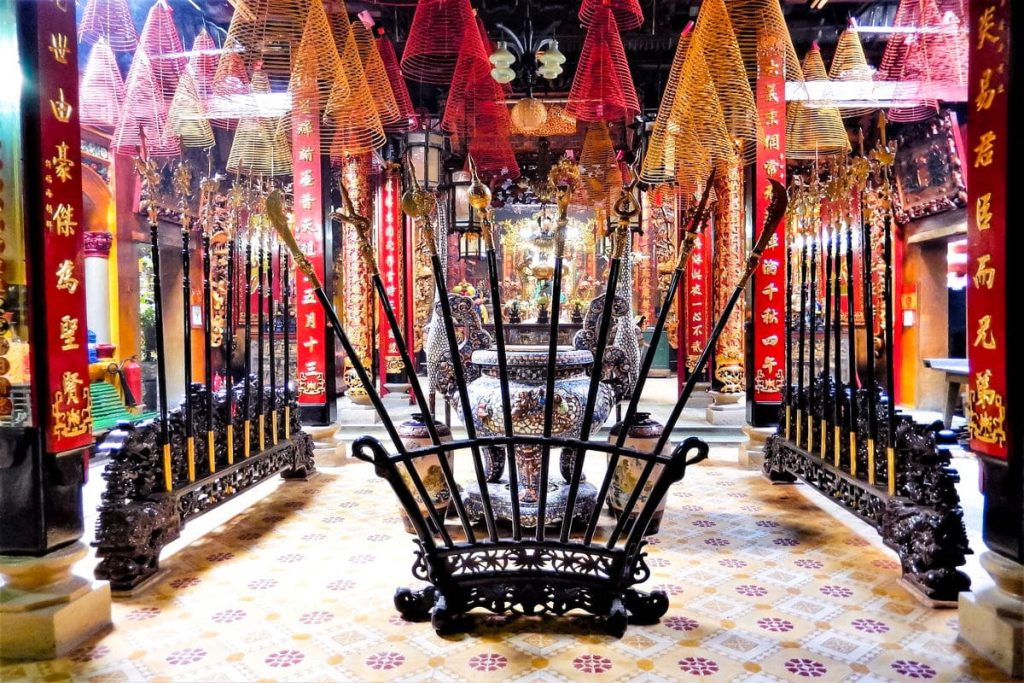
The Complex of Hue Monuments
The remaining remnants of the Nguyen Dynasty can be found in Hue’s core city. The Nguyen emperors built administrative offices, military headquarters, palaces, temples, and even their own tombs here, amid a backdrop of forested hills and a meandering river at their feet.
Vietnam’s feudal capital was situated strategically near the Perfume River’s banks, with convenient access to the sea. Taking influence from Beijing’s Forbidden City, the citadel’s architecture were meticulously planned to be in cosmological alignment with the five elements, cardinal points, and colors.
Walk around the facility at your leisure and watch Imperial Vietnam come to life in full color. Every turn reveals imposing statues, rare jewels, and beautiful mosaics. Despite the fact that the Nguyen Dynasty ended in 1945, the symbolic significance of the Hue Monuments—once the political, cultural, and religious core of Vietnam—remains.
Trang An Landscape Complex
Ninh Binh has long fascinated travelers with its unique combination of sacred temples, tranquil farmland, and stunning karsts. Three features combine to make this one of Vietnam’s most important heritage sites: the Hoa Lu Ancient Capital, which served as the country’s seat of authority in the 10th and 11th centuries, the Trang An Scenic Complex, and the Hoa Lu Forest.
The majestic environment of Ninh Binh is built up of karst peaks and towers that rise steeply up from the valley below, which is covered with peaceful streams and verdant rice farms. Traditional sampans rowed by native guides float smoothly along the river, past lush rainforest and beneath dripping grottoes. Take a short hike to the mossy pagodas and cliff-side overlooks, and you’ll have the complete panorama at your feet.
Hoi An Ancient Town
Hoi An was once a thriving trading port that welcomed merchants from all over the world. Chinese, Japanese, and Europeans settled along the banks of the meandering Thu Bon River between the 15th and 19th centuries. UNESCO has designated 30 hectares of this ancient town as a Cultural Heritage Site.
The small lanes of Hoi An reveal the city’s unique blend of cultural influences. Weathered shophouses rub shoulders with ancestral dwellings, their tiled roofs adorned with exotic wood carvings. An open market, pagodas, and a timber bridge that originally connected the town’s Japanese and Chinese inhabitants may be found tucked away from the ancient ferry wharf. Hoi An is even more beautiful in the evenings, when the fading streets are illuminated by thousands of lanterns.
Ha Long Bay
It’s no wonder that Ha Long Bay has as many legends as it does islands. The name ‘Ha Long’ means ‘descending dragon,’ and Vietnamese legend tells of a dragon descending from the sky and spewing forth hundreds of pearls, which produced the islands and islets we see today.
This magnificent harbor and World Heritage Site spans over the Gulf of Tonkin, 165 kilometers from Hanoi. Secret grottoes, dazzling beaches, and jaw-dropping tunnels are hidden among more than 1,600 limestone formations. An overnight cruise is the greatest way to go. Mornings are for sunrise viewing, tai chi practice, and cave exploration. In the afternoons, guests can swim, kayak, or simply relax on the sun deck. Evenings arrive with stunning sunsets and a relaxing sea air, and they depart with a star-studded sky.
The local life that persists in this dream-like atmosphere enhances the splendor in the harbor. Children row to school on rafts, men fish for a living, and women cook and sell their wares—all in the presence of Ha Long’s spectacular karsts and emerald rivers.
Phong Nha-Ke Bang National Park
Phong Nha, located in Quang Binh Province, is part of the Annamite Mountain Range and has an amazing limestone karst ecology. The park encompasses 126,236 hectares of lush tropical vegetation, massive caves, and underground rivers.
Phong Nha is home to the world’s second-largest cave, Hang Son Doong, as well as a diverse range of cave types such as terraced caverns, intersecting tunnels, and suspended caves. Multi-day expeditions will take you deep into these breathtaking caves, where you may plunge into luminous rock pools and camp beside underground rivers. Local boats will take you into Phong Nha Cave and down the meandering Son River for a more leisurely excursion.
In addition to academically significant caverns, Phong Nha-Ke Bang National Park is home to a high variety of endemic species. The presence of Asiatic black bears, tigers, and saola within the UNESCO-protected area gives wildlife lovers even more incentive to visit Phong Nha.
Museums In Vietnam
Visit one of Vietnam’s many museums, some of which have great collections, to gain a better understanding of the country’s old traditions, culture, and history. The Ho Chi Minh City Museum of Battle Remnants, particularly the terrible collection of war images, will leave an indelible impression. There are English labels, despite the fact that the tone is not entirely neutral. The HCMC Museum is housed in a building worth visiting on its own and provides an interesting look into the city’s history. Visit the gorgeous History Museum, which shows artifacts from many Vietnamese civilizations, for a more comprehensive collection of history. The Museum of Ethnology of Vietnam in Hanoi is an excellent venue to learn about the lives of the country’s ethnic peoples. The Museum of Fine Arts in the city center displays everything from high-quality wood and stone sculptures to fantastic ceramics and textiles. English descriptions.
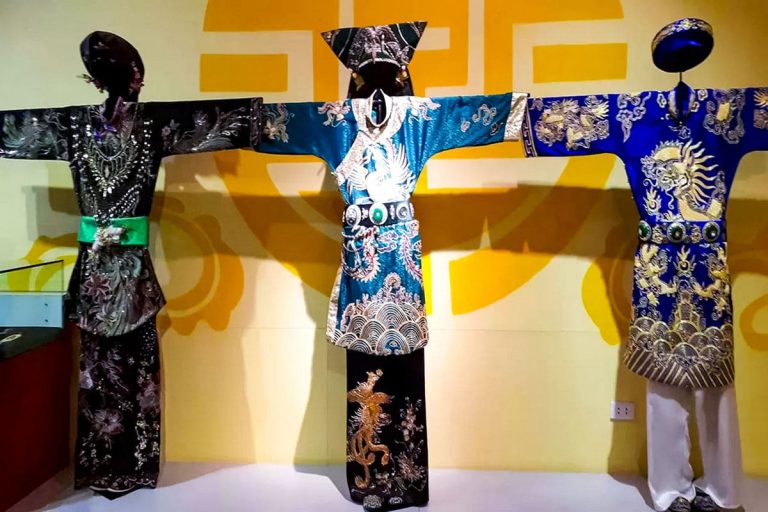
Vietnamese Women’s Museum
The Vietnamese Women’s Museum, located just a few minutes south of Hanoi’s Sword Lake, is a monument to the important role women play in local history and culture. Vietnamese women have long held their own in society, which the museum honors with themed exhibitions and interactive displays. A level of traditional ethnic minority clothing and another telling stories of women who fought for Vietnam on and off the battlefield are highlights.
Admission: 40,000 VND
Hours: 8:00am to 5:00pm daily
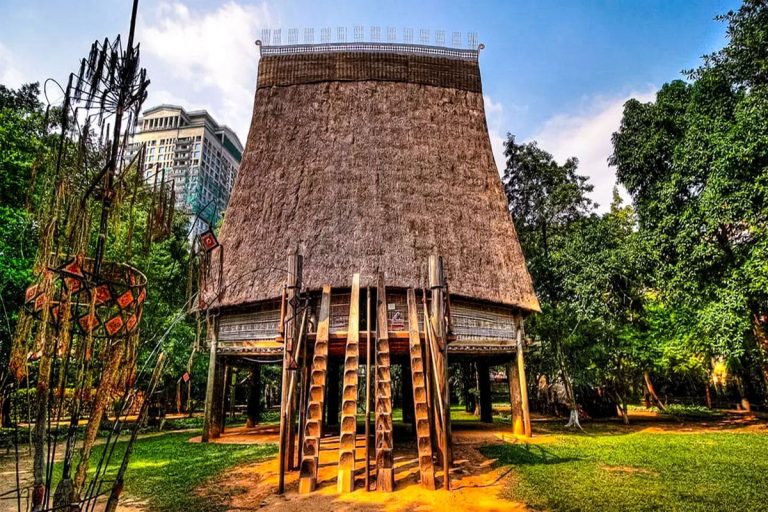
Museum of Ethnology
The Museum of Ethnology provides a new and thorough look into Vietnam’s 54 ethnic groupings. The main hall displays traditional clothes, houses, musical instruments, tools, and prized artifacts from each race. The outdoor exhibits include full-scale models of ethnic minority houses, while the second wing is entirely dedicated to Southeast Asian art.
Admission: 40,000 VND
Hours: 8:30am to 5:30pm daily, closed Mondays
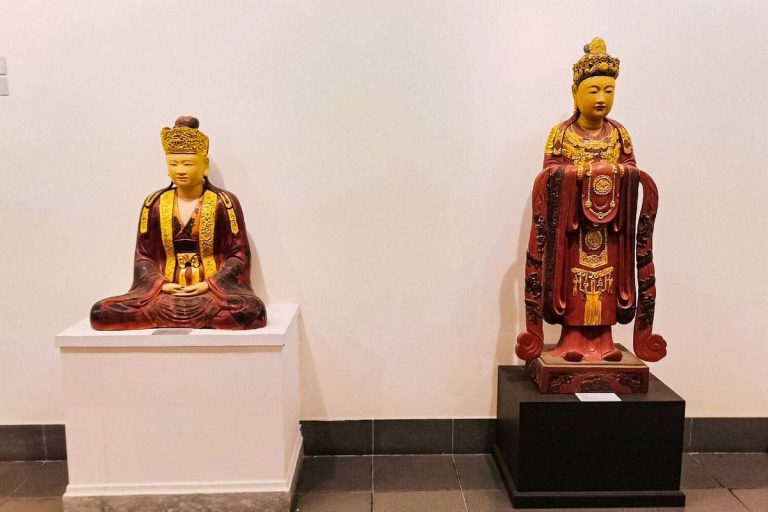
Vietnam National Fine Arts Museum
This pale pink edifice, which was formerly a school for the girls of Indochinese politicians in the 1930s, has been transformed into the Vietnam National Fine Arts Museum. The museum, which houses over 2,000 pieces in various mediums, provides a chronological look at the skills and imaginings of Vietnamese artists before and throughout the twentieth century. This museum, located across the street from the Temple of Literature and a 10-minute walk from the Thang Long Citadel, is a good stop on a Hanoi vacation.
Admission: 40,000VND
Hours: 8:30am to 5:00pm daily, closed Mondays
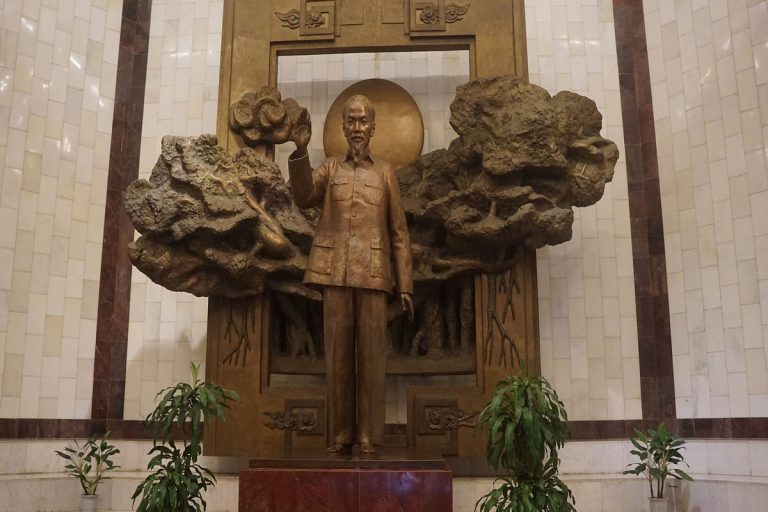
Ho Chi Minh Museum
Ho Chi Minh Museum is a spectacular museum dedicated to the life of national hero Ho Chi Minh and is located behind his final burial place. The main display hall of the museum was designed by students from Hanoi’s University of Fine Arts and takes visitors on a journey through Ho Chi Minh’s life. His history, from rural Vietnam through revolution, is depicted through surreal installations and intricate artwork.
Admission: 40,000VND
Hours: 8:00am to noon daily, 2:00pm to 4.30pm Tuesday to Thursday, Saturday and Sunday
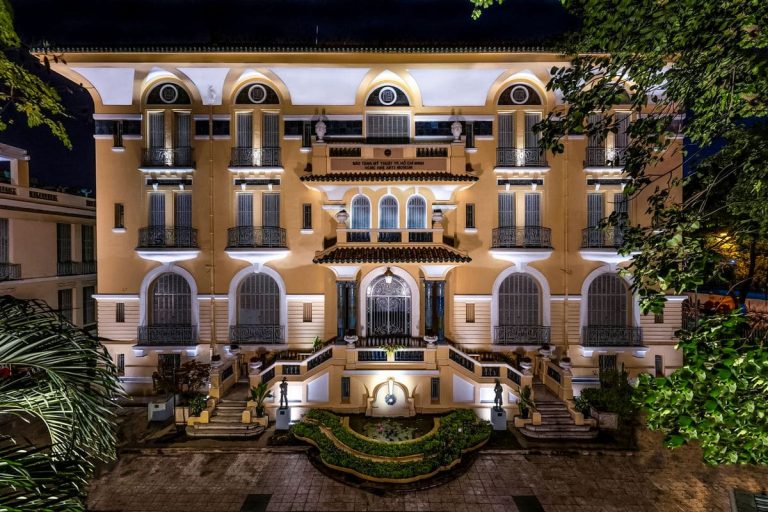
Ho Chi Minh Museum of Fine Arts
The Ho Chi Minh Museum of Fine Arts, housed in the former home of a wealthy Chinese merchant family, is a spectacular example of Indochine-era architecture and home to a diverse collection of valuable works. The first floor has a changing exhibition, while the second floor has sections for sculptures, lacquerware, and traditional woodcut prints, as well as various rooms dedicated to traditional and contemporary Vietnamese art.
Admission: 10,000 VND
Hours: 9:00am to 5:00pm daily, closed Mondays
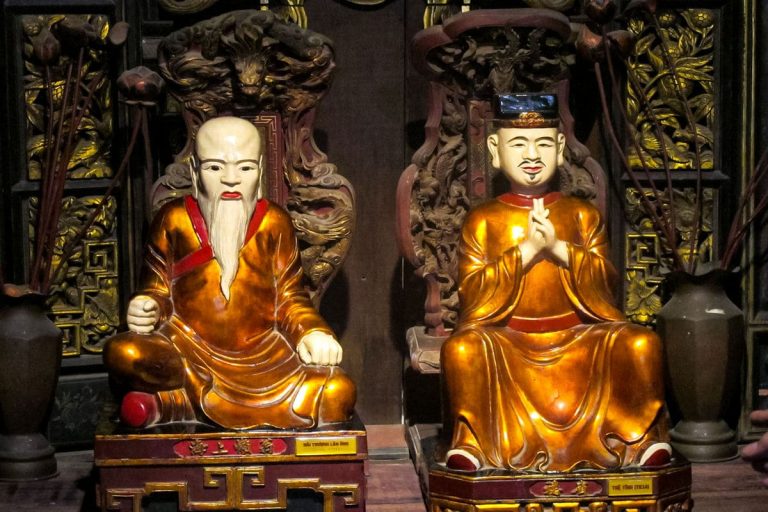
Museum of Traditional Vietnamese Medicine
The Fito Museum of Traditional Vietnamese Medicine recreates a historic apothecary, complete with medicinal herbs, roots, and other goods. Vietnamese traditional medicine has a long history, and the museum’s collection has over 3,000 artifacts dating back to the Stone Age. Learn how herbal treatments have been actively used in Vietnam for millennia and how these traditions are still present in Vietnamese daily life.
Admission: 120,000 VND
Hours: 8:30am to 5:00pm daily
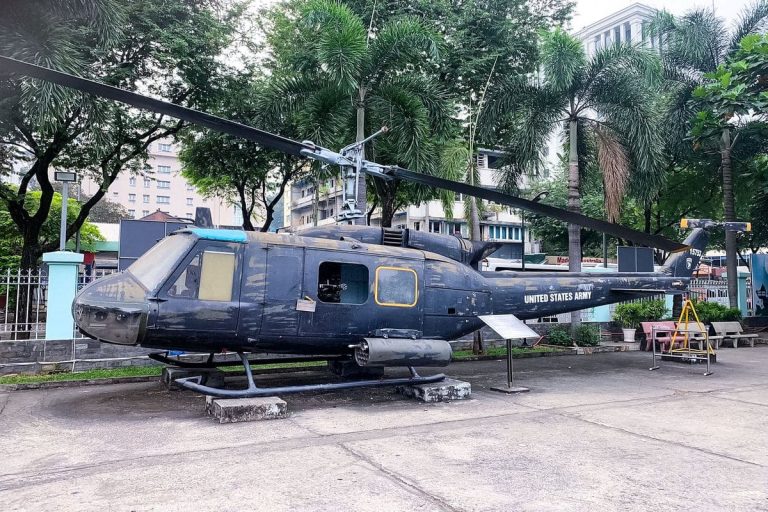
War Remnants Museum
The War Remnants Museum, Ho Chi Minh City’s most visited museum, examines Vietnam’s most difficult years from both sides of the conflict. Exhibitions that are both insightful and heartbreaking shed light on the truth of Vietnam’s war-torn history and its ramifications. This balance is accomplished through contemporary interpretations such as photography and heartbreaking artifacts.
Admission: 40,000VND
Hours: 7:30am to 4:30pm daily
Architecture In Vietnam
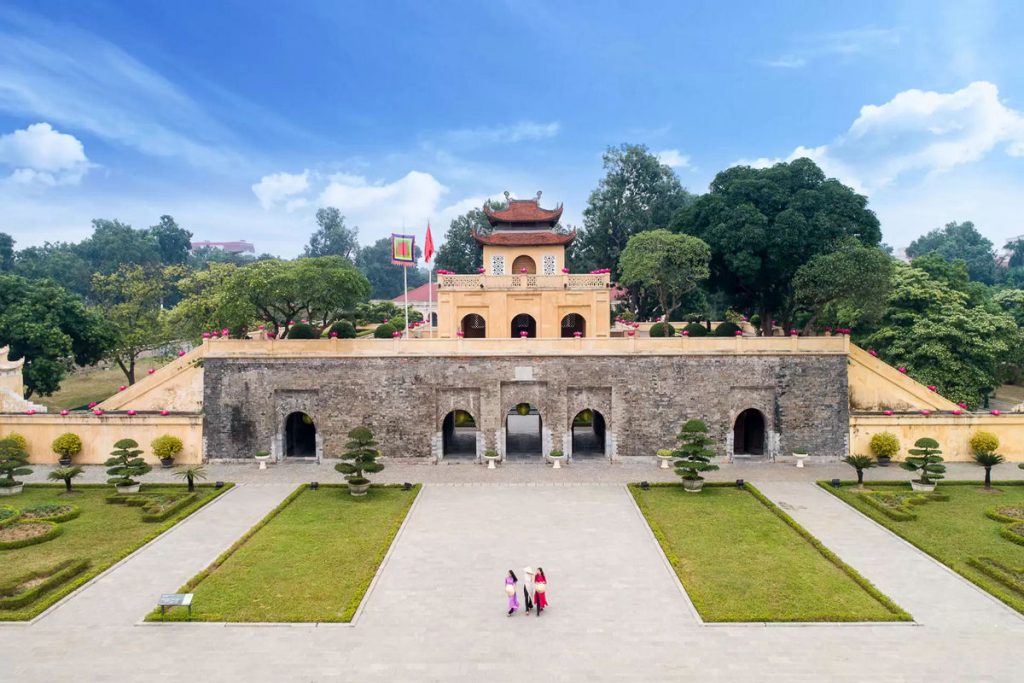
The architecture of Vietnam is everything but conventional. Thousand-year-old temples coexist with gleaming skyscrapers. Modern apartments are nestled atop cream-colored French villas. The ancient and the new, the domestic and the foreign meet in an eclectic combination. This special blend is responsible for Vietnam’s distinctive urban environments and satisfying exploration. Whether you’re an architecture enthusiast or simply a casual observer, this chronological primer will guide you through the best of Vietnam’s must-see architecture.
Cham Towers
From the seventh through the nineteenth centuries, the Cham were a great seafaring nation that settled in regions of Central and Southern Vietnam. Because of their amazing masonry and endurance, Cham stone ruins can still be discovered in Vietnam today. Cham architecture can be found in Da Nang at M Sn Sanctuary, one of Southeast Asia’s largest ancient cities. Another wonderful example from this intriguing time of Vietnamese history is the Po Nagar Cham Towers in Nha Trang.
Cham architecture is strong and beautiful, with intricate carvings influenced by Hinduism. Despite being driven south into the Mekong Delta centuries ago, members of Vietnam’s Cham minority still congregate at temples every year to observe Cham holidays.
Relics of early imperial rulers
Vietnam was divided into 12 fighting kingdoms ruled by terrifying generals in the 10th century. One overthrew the others, establishing Vietnam’s first united and imperial kingdom, I C Vit. His capital was Hoa L, which is now located in Ninh Binh. This remote area was chosen for its steep karsts and flowing rivers, which offered natural barriers against Chinese invasion. The people of Hoa L witnessed three successive dynasties and six monarchs over the span of 42 years, resulting in a combination of temples, pagodas, and fortresses in Ninh Binh.
Vietnam’s capital was later relocated to Hanoi, but the Hoa L Citadel, the previous seat of authority, remains a must-see stop for its exquisite craftsmanship and serene environment. Visit Hang Ma for characteristic Trn dynasty elements and the equally magnificent Bch ng Pagoda for a glimpse at later architectural styles. There are stunning stone steps built into limestone karsts here, as well as pagodas hidden inside ancient rock walls.
Trần Dynasty temples
During the Tran Dynasty, nobility and governance arrived in Hanoi. Many Tran Dynasty monuments, temples, and pagodas still stand in the city today, adding to its architectural richness. The Tran Dynasty is often regarded as Vietnam’s golden age of art, culture, and science. Tran architects championed these concepts, and their work reflects the era’s decadance and progress.
The Thang Long Imperial Citadel in Hanoi, where the Tran monarchs formerly reigned, is a must-see for history buffs. Look notice the enormous flagstaff and antique bulwarks that they constructed to expand the original Ly construction. The Temple of Literature is located somewhat to the south. This Confucian study center was founded around 1070, but it was renovated and improved throughout the Tran Dynasty. The temple has seen various extensions and renovations over the years, but its inventive carpentry, enchanting temples, and numerous courtyards have helped it become one of Hanoi’s most popular tourist sites.
Nguyễn Dynasty citadel and tombs
From 1802 to 1945, the Nguyen Dynasty united the sovereign kingdoms of Vietnam. During their rule, the Nguyen Kings constructed numerous impressive landmarks. During the Nguyen dynasty, royal architecture altered dramatically, gradually absorbing principles of 19th-century French designs. The Nguyen Kings built exquisite tombs in Hue’s countryside. Taken as a whole, these tombs provide a fascinating look at shifting architectural standards and the French influence on Vietnamese society and governance.
Visit the Meridian Gate in the Hue Imperial Citadel to get a sense of the Nguyen Dynasty’s strength. This magnificent stronghold, where the Nguyen Kings lived and reigned, is primarily composed of stone and large wood beams. For the time, the ornate carvings and incorporation of water and moats were exceedingly unique. Behind its massive stone walls, this old fortress boasts numerous secret corners and interesting architecture.
Colonial mansions and cathedrals
Vietnam’s cafe culture, culinary ideas, and architecture have all been influenced by a century of French colonisation. The French introduced western sophistication and engineering. The Long Biên Bridge, a Hanoi landmark erected from 1899 to 1902 and repaired numerous times, is an example of this. The French Quarter in Hanoi is a must-see for anybody interested in colonial French architecture and urban design. Enjoy an evening at the beautiful Opera House, which was established in 1911, or spend the night in Hanoi’s Hotel Metropole, which was envisioned by two French entrepreneurs in 1901.
While the European style introduced by the French was popular in Vietnam, it eventually blended with indigenous tastes. This architectural mix of Vietnamese and French design is one-of-a-kind and intriguing. The Phát Dim Cathedral in Ninh Binh, the Museum of Fine Arts and Notre Dame Cathedral in Ho Chi Minh City, as well as other public buildings in Hanoi and villas in Da Lat and Hue, are examples of this intriguing blending of two worlds.
Brutalist Public Buildings
Brutalism as an architectural style rose to prominence in the mid-twentieth century in the aftermath of WWII. Using concrete in a cubist design and emphasizing symmetry, brutalist architecture became popular in Vietnam. One of Vietnam’s most well-known sights is the Ho Chi Minh Mausoleum in Hanoi’s Ba Dinh District. This massive monument is both a magnificent example of brutalism and the ultimate resting place of Vietnam’s beloved hero.
The Reunification Palace in the south has more brutalist lines. During the American War, the president of South Vietnam lived here. In 1975, the seizure of the Reunification Palace signaled the end of the conflict. The building’s balanced and functional beauty, with elements of Confucian symbolism, distinguishes it in the downtown region of Ho Chi Minh City.
Modern skyscrapers and bridges
The expanding economy of Vietnam heralds the arrival of a new age of urban expansion. Massive buildings are being built in major cities, providing stunning vistas of the changing skyline. Landmark 81 is the highest skyscraper in Vietnam, standing 461 meters tall and visible throughout the city. The construction of this massive structure began in 2015 and was completed in 2018. The Bitexco Financial Building is another iconic feature of the Ho Chi Minh City skyline. The renowned Dragon Bridge and Golden Hands Bridge in Da Nang are both popular photo locations and symbols of Vietnam’s constant onward momentum.




